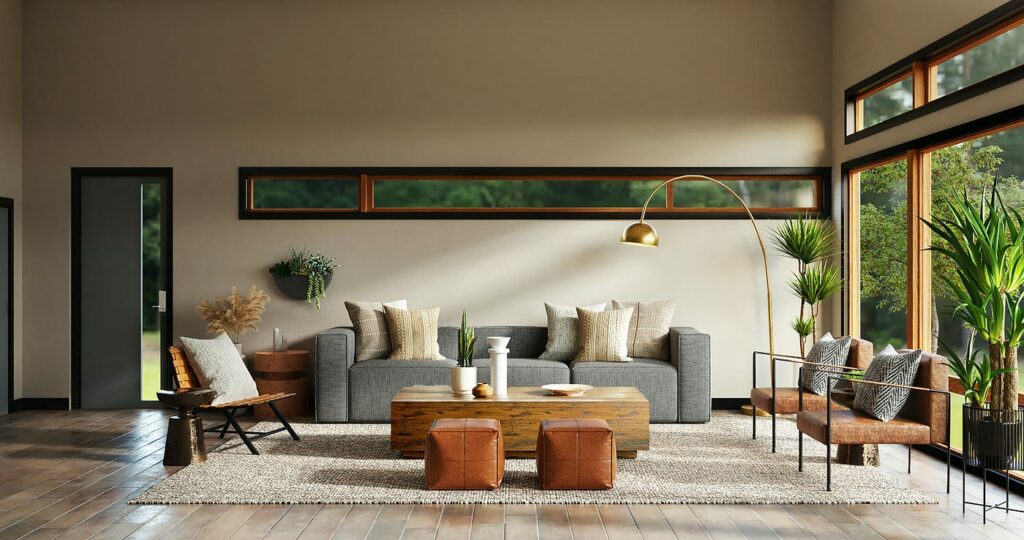Designing Harmony: Creating Balance in Interior Spaces
In interior design, a well-designed space goes beyond just furniture placement and color schemes; it embodies a sense of harmony that resonates with its occupants. Imagine entering a room where every element feels perfectly in sync, creating a visual calmness that transcends the mere arrangement of objects. This is the magic of balance – a fundamental principle that transforms a space from mundane to extraordinary.

A room lacking balance can leave an indelible mark of discomfort, an impression of unfinished business, or an unwelcoming atmosphere. The art lies in the delicate equilibrium between symmetry and asymmetry. The strategic use of these design principles has the transformative power to turn a room into an enchanting, well-balanced environment. In this blog post, we will dig into the importance of achieving balance and harmony in interior design.
The Fundamental Role of Balance
The fundamental role of balance extends far beyond mere aesthetics; it is the very heartbeat of a well-conceived space. A balanced design approach creates a sense of visual calmness that is immediately perceptible upon entering a room. An unbalanced room induces discomfort, leaving an unfinished and disconcerting impression. Delving into the strategic distribution of visual weight—considering furniture placement, architectural features, and lighting—unveils the artistry behind achieving a cohesive and calming environment. This bespoke approach ensures not just visual balance but a nuanced equilibrium that elevates the overall living experience.
The Transformative Power of Harmony
Harmony is characterized by a sense of uniformity, where elements seamlessly coalesce with one another. Achieving this sense of cohesion involves repeating design elements such as color, texture, shape, and form. The repetition of these components emerges as a straightforward and effective strategy for cultivating harmony and crafting a well-balanced composition.
Seeking Professional Guidance
When it comes to creating a harmonious living space, recognizing the expertise of an interior design company in Zurich becomes paramount. These professionals understand the city’s unique design sensibilities, seamlessly blending functionality with aesthetic appeal. Their role goes beyond mere decoration; they are orchestrators of balance and harmony. Through real-life examples of successful interior design projects in Zurich, these experts showcase their ability to transform spaces, elevating them into havens of style and functionality. Seeking their guidance ensures a tailored approach that resonates with Zurich’s design-forward atmosphere.
The Art of Colour: Choosing a Balanced Colour Scheme
Color in interior design is more than a visual treat; it’s a powerful tool that influences the perception of balance and harmony within a space. Recognizing the impact of color on these elements is crucial – hues can evoke emotions and set the tone for a room. Exploring strategies for choosing a balanced color palette involves understanding color theory, considering the room’s purpose, and acknowledging the effects of natural light.
A real-life example that perfectly illustrates the art of color is the interior design of the iconic Hotel Bel-Air in Los Angeles. Renowned for its timeless elegance, the hotel’s color scheme showcases a masterful balance of hues. Soft, neutral tones create a serene atmosphere, while carefully incorporated pops of color, such as subtle blues and greens, add vibrancy without overwhelming the senses.
Symmetry vs. Asymmetry
Symmetry and asymmetry represent two distinct yet powerful approaches. Symmetry, marked by balance and order, creates a sense of stability and harmony in a space. Defined by identical elements mirrored around a central axis, it imparts a classic, formal aesthetic. On the other hand, asymmetry introduces a dynamic quality, fostering visual interest through deliberate imbalance. The charm lies in the unexpected, offering a more relaxed and contemporary feel. Strategic use of both symmetry and asymmetry is the art – a delicate fusion that transforms a space into a captivating environment.
Radial Symmetry: A Unique Design Element
Radial symmetry, often overlooked but undeniably captivating, introduces a distinct design approach. This alternative style revolves around a central point, creating a visually striking arrangement. In interior spaces, it can be implemented through circular patterns in furnishings or decor. By showcasing examples of successful radial symmetry, we witness its transformative power, turning ordinary spaces into focal points of interest. The distinctive visual impact lies in its ability to draw the eye towards a central hub, adding a dynamic and unconventional flair to the overall design aesthetic.
The Transformative Power in Action
The transformative power of balance and harmony comes to life through compelling case studies, showcasing the evolution of spaces under thoughtful design. These real-life examples illustrate the profound impact that a balanced design approach can have on the atmosphere and functionality of a room. Additionally, the voices of satisfied clients shared through testimonials offer firsthand accounts of the positive changes brought about by the expertise of the interior design company. Together, these narratives emphasize the enduring, positive influence of a harmonious living environment on individuals’ daily lives.
Conclusion
The essence of designing harmony lies in the strategic balance of elements, fostering a visually pleasing and functional living space. Embracing professional expertise ensures a timeless, well-balanced, and harmonious environment that transcends fleeting trends, leaving an enduring aesthetic legacy in your living spaces.
